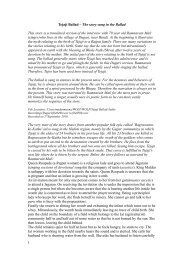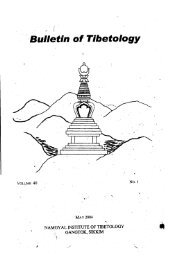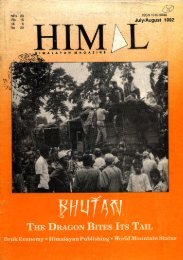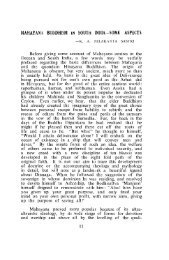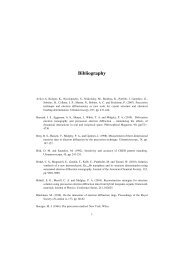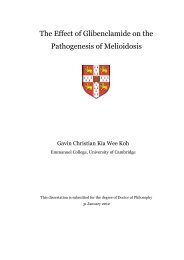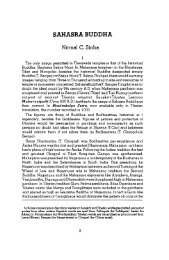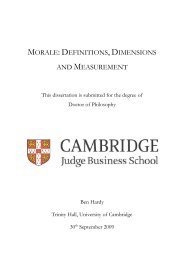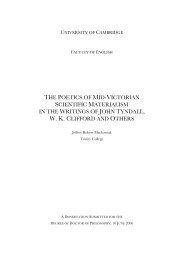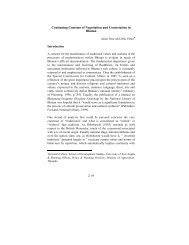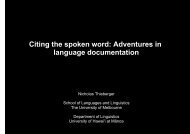The Crusades, the Genoese and the Latin East - DSpace at ...
The Crusades, the Genoese and the Latin East - DSpace at ...
The Crusades, the Genoese and the Latin East - DSpace at ...
Create successful ePaper yourself
Turn your PDF publications into a flip-book with our unique Google optimized e-Paper software.
independence of <strong>the</strong> Embriaci <strong>and</strong> <strong>the</strong> results of this supposed integr<strong>at</strong>ion were not followed<br />
fur<strong>the</strong>r by <strong>the</strong>se scholars. Importantly, scholarship on <strong>the</strong> Italians <strong>and</strong> <strong>the</strong> kingdom of Jerusalem<br />
has traditionally assumed <strong>the</strong> preserv<strong>at</strong>ion of identity <strong>and</strong> ties between <strong>the</strong> communities in <strong>the</strong><br />
commercial settlements <strong>and</strong> <strong>the</strong>ir home towns in Europe. <strong>The</strong> rel<strong>at</strong>ionship between <strong>the</strong> Embriaco<br />
family <strong>and</strong> <strong>the</strong> <strong>L<strong>at</strong>in</strong> <strong>East</strong>, like Genoa's rel<strong>at</strong>ionship with its communities overseas, was more<br />
complex, in my opinion, than is portrayed in <strong>the</strong> historiography. This chapter, which is dedic<strong>at</strong>ed<br />
to <strong>the</strong> special case of Gibelet <strong>and</strong> <strong>the</strong> Embriaco clan, will examine how <strong>the</strong> rel<strong>at</strong>ionship between<br />
Genoa <strong>and</strong> its settlers changed over <strong>the</strong> years.<br />
Genoa <strong>and</strong> Gibelet, a background<br />
Genoa's rel<strong>at</strong>ionship with <strong>the</strong> crusader st<strong>at</strong>es goes back to <strong>the</strong> very beginning of <strong>the</strong> First Crusade<br />
<strong>and</strong> <strong>the</strong> establishment of <strong>the</strong> crusader kingdom of Jerusalem. Ample evidence shows th<strong>at</strong> Genoa<br />
made a significant military contribution to <strong>the</strong> success of <strong>the</strong> crusades. In particular, <strong>the</strong> <strong>Genoese</strong><br />
naval assistance was conspicuous during <strong>the</strong> First Crusade <strong>and</strong> <strong>the</strong> beginning of <strong>the</strong> twelfth<br />
century. Benjamin Kedar, for example, showed how <strong>Genoese</strong> fleets <strong>and</strong> armed forces played a<br />
fundamental role in <strong>the</strong> early years of <strong>the</strong> first kingdom of Jerusalem. He argued th<strong>at</strong> `... <strong>Genoese</strong><br />
assistance was so vital to Baldwin <strong>and</strong> indispensable to <strong>the</strong> conquest of <strong>the</strong> Syro-Palestinian<br />
harbours... '403 Indeed, during <strong>the</strong> early years of <strong>the</strong> existence of <strong>the</strong> kingdom of Jerusalem,<br />
<strong>Genoese</strong> fleets arrived in <strong>the</strong> <strong>L<strong>at</strong>in</strong> <strong>East</strong> every year <strong>and</strong> provided help <strong>and</strong> assistance to <strong>the</strong><br />
crusaders. No less important, however, was <strong>the</strong> role of Genoa during <strong>the</strong> Third Crusade. <strong>The</strong><br />
commitment of <strong>the</strong> commune to th<strong>at</strong> crusade, especially <strong>at</strong> its prepar<strong>at</strong>ory stages, was discussed in<br />
Chapter One. It was argued, for example, th<strong>at</strong> Genoa committed its entire fleet for <strong>the</strong> shipping of<br />
<strong>the</strong> crusaders in 1190, an act which was as significant as Venice's commitment in 1202 to <strong>the</strong><br />
transport<strong>at</strong>ion of <strong>the</strong> crusaders during <strong>the</strong> Fourth Crusade.<br />
In return for its help, Genoa, like Venice <strong>and</strong> Pisa, dem<strong>and</strong>ed <strong>and</strong> received possessions,<br />
legal rights <strong>and</strong> commercial privileges in <strong>the</strong> crusader st<strong>at</strong>es. When given <strong>the</strong> rights to do so, <strong>the</strong><br />
maritime powers established communities overseas, where <strong>the</strong>y <strong>the</strong>n lived in special quarters. In<br />
this manner <strong>the</strong> <strong>Genoese</strong> possessed<br />
parts of many sea-port cities <strong>and</strong> towns in <strong>the</strong> <strong>L<strong>at</strong>in</strong> <strong>East</strong>, such<br />
as Acre, Antioch <strong>and</strong> Tripoli. Gibelet, however, was different because of <strong>the</strong> full ownership<br />
Genoa had over th<strong>at</strong> town. <strong>The</strong> first indic<strong>at</strong>ion of <strong>the</strong> importance <strong>the</strong> <strong>Genoese</strong> <strong>at</strong>tributed to<br />
possessing Gibelet is derived from a financial dispute which took place in Genoa in <strong>the</strong> 1140s<br />
between <strong>the</strong> commune <strong>and</strong> members of <strong>the</strong> Embriaco clan. In 1145, <strong>the</strong> consuls of Genoa<br />
apparently dem<strong>and</strong>ed to confisc<strong>at</strong>e <strong>the</strong> property of <strong>the</strong> heirs of Nicola Embriaco from Genoa,<br />
403 Benjamin Z. Kedar, `Genoa's Golden Inscription in <strong>the</strong> Church of <strong>the</strong> Holy Sepulchre: A Case for <strong>the</strong><br />
Defence', in Gabriella Airaldi <strong>and</strong> Benjamin Z. Kedar (eds. )1 comuni italian! ne! regno croci<strong>at</strong>o di<br />
Gerusalemme (Genoa, 1986), p. 327.<br />
115



